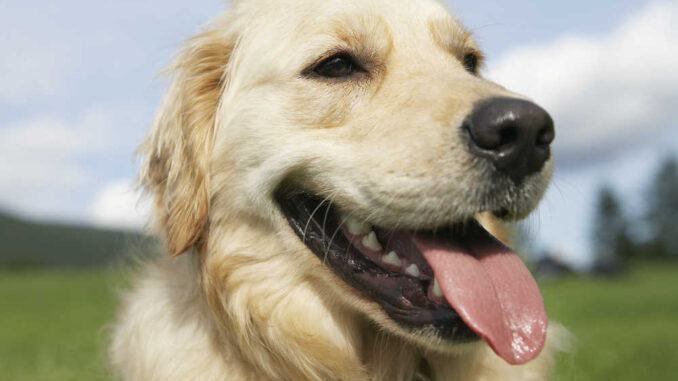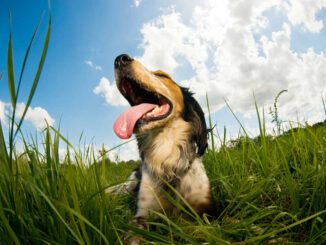
For every dog parent, the well-being and comfort of their furry friend is a top priority. When your female dog enters her heat cycle, it often brings with it a set of changes, behaviors, and symptoms that can be concerning or unfamiliar. One common question: Is it normal for a dog in heat to pant? In this article, I’ll provide a vet’s perspective on reasons you may notice increased panting during a heat cycle and offer practical tips to ensure your dog remains comfortable during this time.
About the heat cycle in dogs
When we say a dog is “in heat,” we’re referring to her estrus cycle, which is the time she becomes receptive to mating. Most dogs have their first heat cycle when they reach sexual maturity between six and nine months of age. However, larger breeds might not experience it until they’re 12-18 months old.
The heat cycle encompasses four phases:
- Proestrus: The start of the cycle, marked by a bloody discharge and swelling of the vulva.
- Estrus: When the dog is fertile and may accept mating by a male.
- Diestrus: After the fertile phase, even if the dog hasn’t mated.
- Anestrus: Resting period till the next cycle.
Each heat cycle lasts two to four weeks on average and generally occurs every six months, although this can vary between breeds and individual dogs. A swollen vulva and bloody vaginal discharge are the most obvious signs that your dog is in heat, but you may also notice behavioral changes such as clinginess, restlessness, aggression, increased urination, and increased licking of the vulva.
Overview of excessive panting during a heat cycle
Panting refers to rapid (200-400 breaths per minute), shallow, open-mouth breathing. Panting is a dog’s primary way of regulating body temperature and can also be a response to various emotional and physical states. During the heat cycle, many changes occur within a dog’s body. These alterations can sometimes lead to increased panting, making it a frequent concern for many pet owners.
Why is my dog panting a lot during heat? Most likely reasons
1. Hormonal Influences
The heat cycle triggers a cascade of hormonal changes. These hormonal fluctuations can affect a dog’s internal temperature regulation. Just as in humans, where hormonal shifts can lead to hot flashes or increased sweating, dogs might experience something similar — leading to increased panting.
2. Behavioral Factors
Being in heat can make a female dog more restless or agitated. This heightened state of activity or anxiety can be a major factor that contributes to increased panting. Additionally, seeking potential mates, marking territories, or even evading male dogs can be physically demanding, further resulting in panting.
3. Stress and Anxiety
The heat cycle can be a stressful time for some dogs. This anxiety, whether from the internal changes they’re experiencing or from the increased attention they might be getting from male dogs, can manifest in symptoms like panting.
4. Other Potential Causes
While the heat cycle can be a reason for increased panting in many female dogs, it’s essential not to rule out other potential causes. Environmental factors (high outside temperatures), underlying medical conditions (such as fever, Cushing’s Disease, heart disease, lung disease, or neurological conditions), side effects from certain medications, and even pain, can lead to excessive panting.
Does this mean my dog is in pain or uncomfortable?
Panting during a dog’s heat cycle can be a natural response to the hormonal changes taking place in her body, and it doesn’t necessarily mean she’s uncomfortable or in pain. However, excessive or unusual panting, especially when paired with other concerning symptoms, should be addressed. Always consult with your veterinarian if you’re unsure or worried about your pet’s well-being.
Why won’t my dog stop panting? Is there another triggering factor?
Panting is a natural and typical behavior for dogs, but excessive or unexpected panting can be an indication of underlying issues. It’s always advisable to monitor any changes in a pet’s panting patterns and consult with a veterinarian if there are concerns. Here are additional reasons that dogs may pant excessively.
- Thermoregulation: Unlike humans, dogs have a limited number of sweat glands, which are mostly located on their paw pads. This means they can’t sweat in the same way humans do to cool down. Instead, dogs use panting as their primary method to release excess heat from their bodies. When a dog pants, they evaporate moisture from their tongue and mouth, which helps lower their body temperature.
- Physical Activity: After vigorous play or exercise, a dog may pant to help regulate body temperature and recover from the activity.
- Excitement or Stress: Emotional responses can also lead to panting in dogs. Whether they’re excited about a car ride or feeling anxious during a thunderstorm, these emotions can manifest in increased respiratory rates.
- Medical Reasons: Sometimes, panting can be a sign of a medical issue. Conditions such as pain, certain diseases (like Cushing’s disease), respiratory disorders, cardiovascular problems, and some medications can lead to increased panting.
- Other Factors: Panting can sometimes be influenced by external factors like hot weather or environments where the dog might feel overheated.
Steps you can take at home to help your female dog
These steps may be beneficial if your female dog is panting and in heat:
- Provide a Cool Environment: Ensure your dog always has a cool, shady place to rest.
- Always Have Fresh Water Available: Always provide access to fresh, clean water.
- Reduce Stressors: Create a quiet space for her, away from loud noises or disruptions. Provide soft bedding and toys that she enjoys. Some dogs find comfort in pheromone sprays or diffusers, like Adaptil.
- Ensure Safety and Prevent Unwanted Litters: Keep her completely separated from intact male dogs. Always keep her leashed on walks and never leave her outdoors unsupervised.
- Sanitary Measures: Use doggy diapers or pads to manage discharge. You can gently clean her vulvar area with unscented baby wipes or a damp cloth.
- Consider Spaying: If you do not plan to breed your female dog, spaying is strongly recommended for her health and longevity.
- Consult with Your Veterinarian: If panting seems excessive or if there are other worrisome symptoms, always reach out to your vet for guidance. Occasionally after a heat cycle a female dog can develop other issues, such as pyometra (uterine infection) or false pregnancy.
Veterinarian visit or wait-and-see?
This depends on the extent of the panting and if you are noticing any other concerning symptoms in your pup. While panting can be a normal and natural response, it’s essential to recognize when it might be concerning:
- Continuous, relentless panting might be a red flag. This kind of panting does not stop after a short rest period or doesn’t seem to be related to recent physical activity or external temperatures.
- Heavy or strained panting, especially if the dog appears distressed or is having difficulty breathing.
- Other Symptoms: If panting is accompanied by other worrying signs, such as coughing, increased respiratory effort, lethargy, loss of appetite, vomiting, or diarrhea, seek veterinary advice.
Disclaimer: This website's content is not a substitute for veterinary care. Always consult with your veterinarian for healthcare decisions. Read More.





Be the first to comment